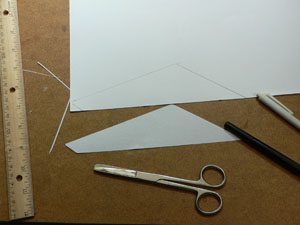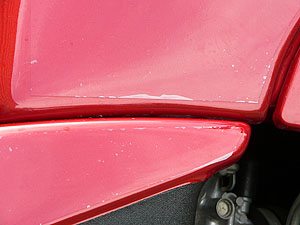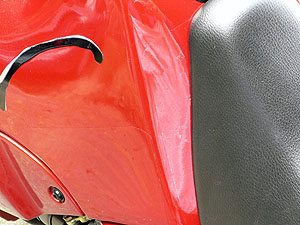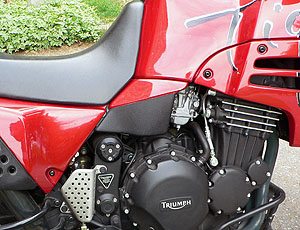Motorcycle paint is like a magnet for bugs, road grime and dirt. That noxious mixture is bad enough, but factor in harsh Cordura or leather clothing, tank bags, bungee cords and motorcycle boots and it’s surprising that the paint lasts more than a single season.
This problem is exacerbated on adventure-touring bikes, because they frequently see more dirt and dust than sportbikes or cruisers.
Automotive and motorcycle paint technology has come a long, long way in the past few decades, and the common use of thick clearcoats has been an enormous help in making finishes last much longer than ever before.
Maybe some day we’ll get a diamond-like coating that makes paint scratchproof and eternally shiny, but in the meantime, motorcycle paint can use some help, especially in the areas most prone to chafing.
Whenever we acquire a new motorcycle, one of the first things it gets is a treatment with paint protection film. We’ve been using 3M’s Scotchcal with good results, but Snider’s Products sent us over some of their “Paintgard” paint protection film to try on our “new” ’98 Tiger.
What’s the difference? We discovered that there are enough differences between the two paint protection systems to warrant another article.
While both products seem to be nearly identical, Scotchcal is 0.37 mm thick, it has an adhesive backing and it is a semi-permanent paint protection film. It’s relatively easy to remove by peeling it off, but it can’t be used again. Compared to the Paintgard paint protection film, Scotchcal is, in our opinion, trickier to install, because the adhesive can set up as the film is being installed, making it hard to remove the air pockets that form underneath the film.
However, once the air pockets and bubbles are worked out from under the Scotchcal, the adhesive helps to keep the film in place right up to the edges. Although it takes longer to work the Scotchcal paint protection film on to curved surfaces, once the air pockets are removed, the product becomes just about invisible.

Paintgard paint protection film is 0.19 mm thick and it clings to the painted surface without adhesive. We’re guessing it works by either static electricity or some other scientific property that’s beyond our limited grasp of Physics. The 11″ by 14″ sheets of clear film are placed on a paper backing for shipping purposes.
Since Paintgard has no adhesive, the pattern can be traced directly on the paper backing without having to worry about a left or right side.
Scotchcal can only be applied in one direction; (i.e., only one side has the adhesive and must be applied to the painted surface), it must be cut in a mirror image when applying it, for example, to both sides of the fuel tank or both sides of the battery covers.
The thinner Paintgard film is more flexible and easier to cut with scissors or a razor knife. We use plain computer printer paper to trace the desired pattern on the motorcycle, then transfer it to the film.
The mounting instructions for both products are similar — first clean the surface (we use rubbing alcohol to remove old polish or wax), then spray with a mixture of water, alcohol and a drop or two of dishwashing liquid, and slide the film into place.

Working with the Paintgard is very easy, because it can be peeled off and re-positioned without having to worry about any adhesive setting up.
It does slide around more easily than Scotchcal when applying it, which can be an advantage. But it’s easy to move it out of position with the squeegee (used to remove the air bubbles), although this isn’t really a problem because the Paintgard is so easy to re-apply.
The Paintgard doesn’t seem to grip as tightly at the edges, especially in areas with a compound curvature. See Photo 2. It works better if it’s kept on a flat surface, slightly offset from the edge of a curve, like at the bottom edge of a fuel tank.
As the Paintgard is being applied, the air bubbles are removed using a squeegee or credit card. We noticed that more air pockets seem to remain under the Paintgard than the Scotchcal film, probably because of the Scotchcal’s adhesive backing.
Snider’s says that one of the advantages of Paintgard is the ability to peel it off and reuse it. We’re not sure how often this will be necessary — once we install paint protection film on any of our motorcycles, it stays on for good. But perhaps this feature would be useful for show bikes or antique motorcycles, where the paint protection film could protect the bike during a ride but can easily be removed to return the bike to original condition.

We were concerned that the Paintgard wouldn’t stay in place during the rigors of riding, but we’ve had no problems in this regard. It’s remained in place and seems to do a good job of protecting the painted surfaces on the sides of the Tiger’s fuel tank and batter covers, which get direct contact with the rider’s legs on every ride.
We haven’t yet polished the bike with the Paintgard in place. Normally, we’ll simply polish right over the Scotchcal without worries that it might become loose. Vinyl paint protection film doesn’t shine up as well as the unprotected painted surface, and the softer vinyl can become scratched, but that’s a small price to pay for the excellent protection it provides.
It’s possible that the Paintgard will move around on the surface if we try to polish over it, but since it’s so easy to re-apply, this shouldn’t be much of a problem.
By the way, Snider’s also sells sheets of real carbon fiber for use as paint protection or as appliqués to dress up a bike. The product has a very sticky adhesive backing. We couldn’t really find any good places to use it on either the Tiger or any other motorcycles we had in the garage, but we’ll keep it in mind for the future.
Where to Buy Paint Protection Accessory
Check Reviews & Prices on AmazonSee More: Motorcycle Accessories, Motorcycle Tire, Motorcycle Helmets
Conclusion
Overall, we like the Paintgard paint protection system. Snider’s is currently running a sale, and three 11″ by 14″ sheets cost just $13.50. The product is easier to apply than Scotchcal, which is a plus for anyone without practice in using these type of products. Paintgard also seems to provide just as much protection as other paint protection systems.
Note: For informational use only. All material and photographs are Copyright © webWorld International, LLC – 2000-2011. All rights reserved. See the webBikeWorld® Site Info page. NOTE: Product specifications, features and details may change or differ from our descriptions. Always check before purchasing. Read the Terms and Conditions!
| Product Review: Paintgard Paint Protection Clear Vinyl | |
| Available From: Snider’s Products | Suggested Retail Price: $13.50 for 3 sheets |
| Colors: Clear (Carbon fiber also available) | Made in: U.S.A. |
| Product Comments: Easy to apply. Flexible. Can be reused. Protects paint from stone chips, scratches, chafing from clothing or bungee cords, etc. | |
| More: wBW Motorcycle Accessories Page | |
More Paint Protection Sources: Eric on Triumphnet sells pre-cut Scotchcal appliqués for Triumphs; he has bulk Scotchcal for any other bike, other Scotchcal supplies and very good instructions on installation; he also ships internationally; I’ve purchased from him and was very satisfied with the transaction and his help | Dallas Motorcycle Accessories sells “SheerMask” pre-cut kits for the K1200LT, R1100-1150RT and K1200RS and other bikes; the kit is custom designed to fit the lower fairing chin guard, gas tank, ignition and gas tank | Tankslapperalso carries a type of paint protection film; they have pre-cut templates for many bikes | Invinca Shield also carries protective film with many kits for motorcycles | Secondary Exposure Incorporated carries paint protection films also



No Comment